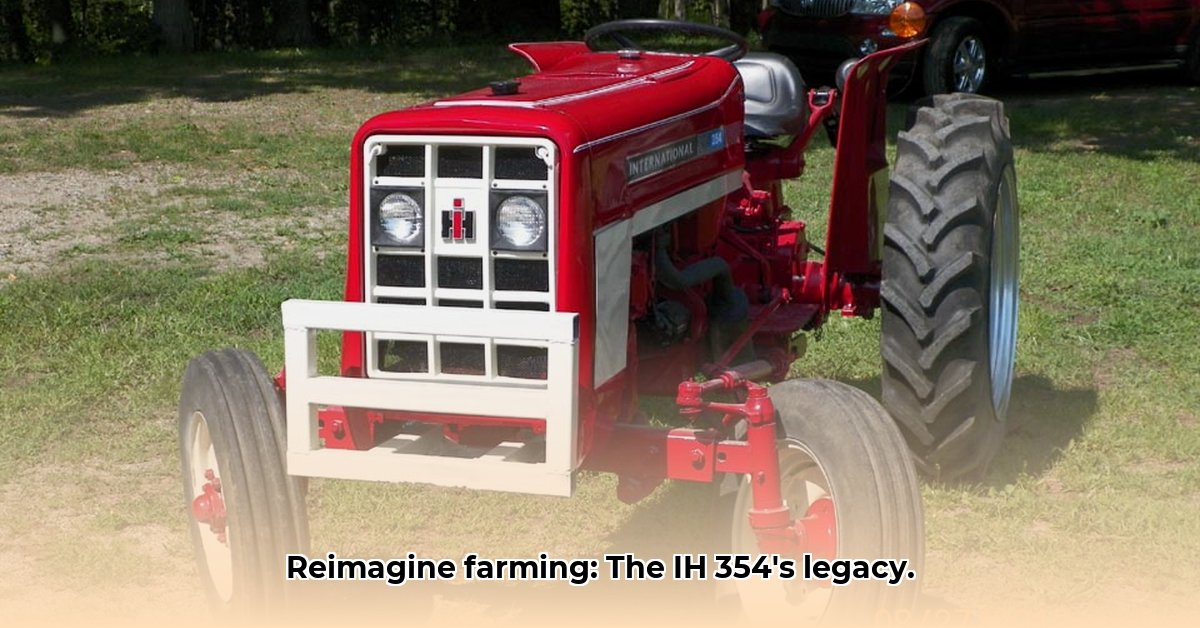
The International Harvester 354: A 1970s Farming Icon
The International Harvester (IH) 354 tractor, produced from 1971 to 1975, stands as a powerful symbol of agricultural mechanization during a transformative decade. This article delves into the technical specifications, historical context, and—crucially—the sustainability implications of this iconic workhorse. We will examine its design, its role in the farming practices of the 1970s, and its legacy in relation to modern sustainable agriculture. Understanding the IH 354 offers a unique perspective on the evolution of farming technology and its environmental footprint. For more on older IH tractors, see this site.
Technical Specifications: Power and Performance Under the Hood
The IH 354 boasted a robust build, designed for the demanding tasks of farm life. Farmers could choose from gasoline or diesel engine options, both delivering a respectable 35 horsepower for the time. Its features included power steering and reliable mechanical disc brakes, enhancing maneuverability and control. With a fuel tank capacity of approximately 12.2 gallons (46.2 liters), it offered extended operational periods. Weighing in at 4040 lbs (1832 kg), the 354 was built for durability and could handle a variety of challenging tasks. While lacking the climate-controlled cabs of modern tractors, its open operator station provided excellent visibility.
| Feature | Specification |
|---|---|
| Model | International Harvester 354 |
| Production Years | 1971-1975 |
| Engine Types | Gasoline, Diesel |
| Horsepower | 35 hp |
| Fuel Capacity | 46.2 L (12.2 gallons) |
| Weight | 1832 kg (4040 lbs) |
| Key Features | Power steering, Mechanical disc brakes, Open operator station |
Farming in the 1970s: A Period of Transition
The IH 354's production years overlapped with a period of significant agricultural transformation. Mechanization was accelerating, but its adoption varied across farms. While data shows a rise in 354 production from 1972-1974, further research is needed to understand the driving factors behind this increase. Was it simply replacing older equipment, or were economic factors at play? Analyzing economic conditions and farming practices of the time would greatly enrich this historical narrative.
Sustainability: A Historical and Contemporary Perspective
Assessing the IH 354’s sustainability requires a nuanced approach. Precise data on fuel efficiency and environmental impact are limited. Compared to modern tractors, its fuel consumption likely was higher, and the open operator station likely contributed to operator fatigue and less precise work. However, we must consider the historical context. Environmental awareness and available technologies were significantly different in the 1970s. This necessitates a careful comparison of its environmental impact with contemporary and modern machinery, which remains as a critical area for future research.
Stakeholder Perspectives: Multiple Lenses on the IH 354
Gaining a comprehensive understanding of the IH 354 demands incorporating diverse perspectives. Agricultural historians can illuminate the broader context of 1970s farming practices. Vintage tractor collectors offer firsthand insights into the machine's durability and appeal. Finally, experts in sustainable agriculture can analyze its environmental impact using modern analytical frameworks. Synthesizing these viewpoints provides a more complete picture of the 354's legacy.
Future Research: Unanswered Questions
The IH 354's historical significance is undeniable, yet many questions remain. Future research should prioritize a detailed comparative analysis of its fuel consumption and emissions against modern tractors. Moreover, investigating the design choices related to its efficiency and environmental consequences is vital. Finally, exploring its role within the broader agricultural trends of the 1970s is needed to fully understand its place in history.
Pivotal Points:
- The IH 354's durability and repairability, reducing the need for frequent replacements, offered an environmental benefit.
- Its relatively high fuel consumption, compared to modern standards, presents a key area for comparative research and analysis.
- The tractor's simplicity, while enhancing maintainability, lacked the precision and fuel efficiency of modern farming technology, leading to less-precise work and greater fuel consumption.
The International Harvester 354 deserves further study to more completely understand its influence on 1970s agriculture and to fully appreciate its place in the broader story of sustainable agricultural technology. Its legacy continues to resonate, prompting us to consider the evolving relationship between technological advancement and environmental responsibility.